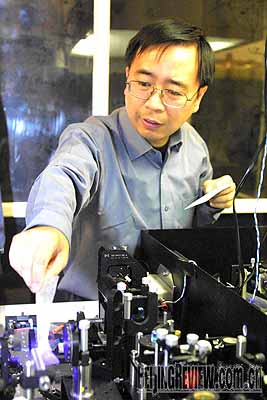|
|
 |
|
SCIENTIST AT WORK: Professor Pan Jianwei conducts an experiment in long-distance quantum transmission at a laboratory in Vienna, Austria (LIN CHUAN) | In the information age, transmitting data securely is of the utmost importance. Now a more secure encryption system, called quantum communication technology, is on the horizon, which could change the face of communication.
Quantum communication is totally classified since it cannot be cloned. According to the theory of quantum mechanics, any eavesdropper intercepting information transmitted by quantum would change the state of information and hence be immediately detected. If the input and output information match exactly, it indicates that the communication is completely confidential.
A significant breakthrough in quantum communication was recently made in Hefei City, capital of Anhui Province. Scientists removed a large stumbling block in quantum communication with a quantum RP repeater. The breakthrough was made by Pan Jianwei, a professor at the Hefei-based University of Science and Technology of China, and his colleagues.
Long-distance quantum communication used to be hampered by inevitable photon loss in the transmission channel. To extend the achievable communication distance, Briegel, Dür, Cirac and Zoller (BDCZ) introduced the concept of quantum repeaters, which combine entanglement swapping and quantum memory. Pan and his colleagues realized entanglement swapping with storage and retrieval of light. Their paper was published in Nature magazine on August 28, 2008.
Some media, including China's Science and Technology Daily, rated this breakthrough among the top 10 biggest scientific news items of 2008.
Entanglement
Quantum entanglement is a basic theory in quantum mechanics. "Even though separated by a long distance, the particles are correlated with each other," Pan said.
Pan took two electrons traveling in opposite directions at the same speed as an example. He said that the two electrons are related even though one may get to the sun, and the other to Pluto. When one is manipulated and measured, the other one will also respond instantaneously and change state accordingly. It seems that the two electrons are secretly talking to each other at a speed faster than light.
As early as the 1930s, entangled states were first investigated in a famous paper by Albert Einstein, Podolsky and Rosen (EPR). Even Einstein seemed to be confused, and he famously derided entanglement as "spooky action at a distance."
Entanglement was studied in computation science in the late 1980s. Now, an increasing number of scientists think entanglement a superforce in quantum computers that promises secure cryptology in quantum network communication. Quantum entanglement cryptology is key for telecommunication technology to leap forward from pulse communication.
How to apply quantum entanglement in quantum computation and quantum communication remains a challenge in the real world. Simple entanglement of three or four particles is not enough for universal quantum error correction, so five-photon entanglement along with correlation control is required. The preparation and manipulation of five-photon entanglement is very technically challenging.
With funding from several national science projects including the National Natural Science Foundation Project, Pan and his colleagues have worked hard for three years, tackled many technical problems and eventually realized the preparation and manipulation of five-photon entanglement. They are the first group of scientists to have achieved this, according to the website of the University of Science and Technology of China.
They utilized five-photon entanglement to demonstrate a more novel teleportation in experiments, that is, open-destination teleportation. An unknown quantum state of a single particle is teleported onto a superstition of N particles; at a later stage, this teleported state can be read out at any of the N particles, by a projection measurement on the remaining particles. This novel teleportation protocol is a key process in quantum error correction and distributed quantum information processing.
| 